K
|
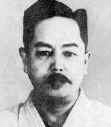
' KUNSHI no KEN ' ( The Noble Discipline )
KENWA MABUNI (1889-1952) was born in Shuri, the 17th generation descendant of one of the bravest warriors of Okinawan nobility. As a child, Kenwa Mabuni wanted so very much to be like his great ancestors, but, unfortunately he was very sickly and weak. In 1902, at the age of 13, Kenwa Mabuni was taken to the most famous martial artist in Shuri, master Ankoh Itosu, to improve his health. From that day forward, he never missed a day of training until he was approximately 20 years old.
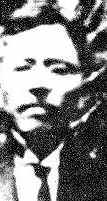
Ankoh Itosu
In 1909, encouraged by master Itosu to further expand his knowledge of the martial arts, and on the advice of his best friend Chojun Miyagi, Kenwa Mabuni, began taking lessons from master Kanryo Higashionna of Naha, until the great master's death in 1915.
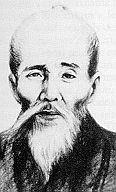
Seisho Arakaki (1840-1918)
During this period, Kenwa Mabuni was also receiving instruction from master Seisho Arakaki (1840-1918) of Naha, who taught a similar style to master Higashionna. Master Arakaki was an accomplished Kobujutsu teacher and taught Kenwa Mabuni BO and SAI techniques, including various weapons forms. He was also being influenced by a Fukien, 'White-Crane-Fist' master named WU XIAN GUI (pronounced GO KENKI in Japanese) at the time.
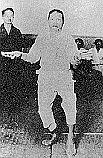
WU XIAN GUI
(Kenwa Mabuni in background at left).
Upon hearing of Master Itosu's death in 1915, Kenwa Mabuni was so upset that legend indicates he built a shrine in front of Master Itosu's grave and looked after the gravemarker. He would come to the grave site and diligently practice his kata daily, for over a year, to pay respect and honour to the great master.
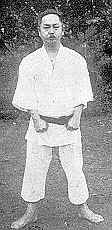
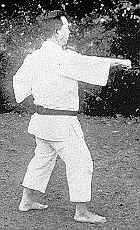
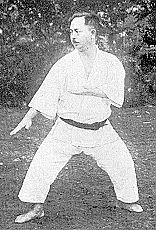
Completing the required military service after graduating from high school, Kenwa Mabuni eventually became a policeman. By 1918, Kenwa Mabuni had become an important figure in the martial arts community and was respected by his peers. Around this time, he established a research and study group at his home. Various participating members included Chosin Chibana, Gichin Funakoshi, Anbun Tokuda, Shinpan Shiroma, Choju Oshiro, Seicho Tokumura and Hoko Ishikawa. During 1918, Kenwa Mabuni's first son, Ken-ei, was born.
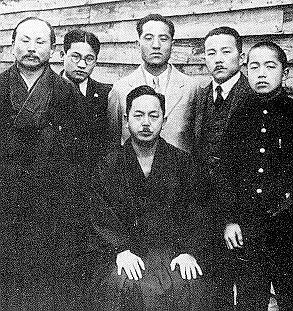
Master Kenwa Mabuni (seated).
(L to R): Master Gichin Funakoshi, Genwa Nakasone, unknown,
Yasuhiro
Konishi, Kenei Mabuni.
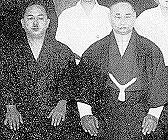
Mabuni Sensei and Choki Motobu.
It was later in the same year, that Kenwa Mabuni was to have the great honour of demonstrating his martial arts in the presence of Prince Kuni and Prince Kacho at the Okinawa Normal School. While Gichin Funakoshi was sent, as the official representative to introduce Okinawan 'TODE' to mainland Japan in 1922, Kenwa Mabuni and the research group members including, Juhatsu Kiyoda, Choyu Motobu, Go Kenki and Chojun Miyagi continued to train together.
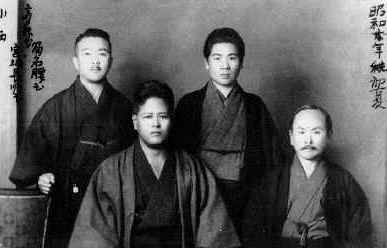
Back row (L-R): Yasuhiro
Konishi, Tatsuo Yamada.
Front row (L-R): Chojun Miyagi, Master Gichin Funakoshi.
In 1924, Kenwa Mabuni and Chojun Miyagi, were asked to take charge of the training sessions, even though they were still fairly young. During these sessions, actual kumite was stressed to increase their physical techniques and strength. It is said that, when a student wanted to learn more from a master, the master would simply invite the student to attack him freely, all the while, blocking and shifting his body while constantly asking the student, "Now, do you understand?" and encouraging them to attack, again and again.
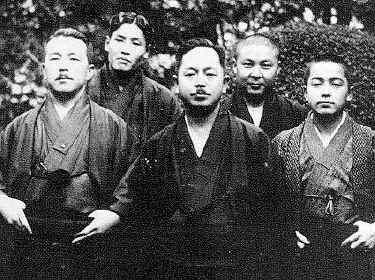
(L-R): Yasuhiro (Koyu) Konishi, a friend, and training partner of Kenwa Mabuni,
traveled with him to Japan in 1925, where they taught and demonstrated
their martial arts at various locations.
R: Kenei Mabuni.
Between 1925-1927, Japan's leading government sanctioning martial arts body, eventually accepted Okinawan 'TODE' as a member. It was during this period that the generally accepted reading of the KANJI (particular style of written characters) for "TODE' meaning 'CHINA-HAND' was changed to the Kanji of 'KARA-TE', meaning 'Empty-HAND'. The reading of the Kanji was not widely accepted, especially in Okinawa, until much later in 1936-1937.
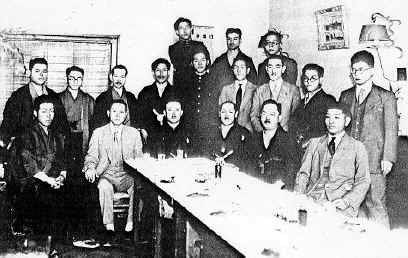
Front row (L-R): Tatsuo Yamada, Hironori
Otsuka, Yasuhiro Konishi, Sannosuke Ueshima,
Kenwa Mabuni. Back row, 4th from left: Gogen Yamaguchi.
The Japanese government's martial arts sanctioning organization, the Dai Nippon Butoku-Kai, began to demand the different groups applying for membership be more specific in the description of their Karate systems, and pressured them to name their systems. Kenwa Mabuni originally named his system 'HANKO RYU' (Half-Hard style), but, later changed it to reflect the deep respect he felt towards his two great masters, ITOSU and HIGAONNA. Using the alternative reading of the Kanji for 'ITO' from master ITOSU's name, (which can also be read as 'SHI' ), and 'HIGA' from master HIGAONNA's name, (which can be interpreted as 'TO' ), Kenwa Mabuni created the new name, 'SHITO' for his style of Karatedo.


It was during this time 1927-1928, that Kenwa Mabuni moved to Osaka permanently, to teach Shito Ryu Karatedo.Around 1929, master Moden Yabiku was also teaching Karatedo and Kobudo in Japan. His most famous student was master Shinken Taira (1897-1970) who also trained under master Mabuni during the late 1930's. Ryusho Sakagami (1915-1993), founder of the NIHON KARATEDO ITOSU KAI, began training under master Moden Yabiku in 1934, and then in 1937, became a student of master Kenwa Mabuni. Sakagami sensei also received a teaching certificate in Kobudo, from master Shinken Taira.
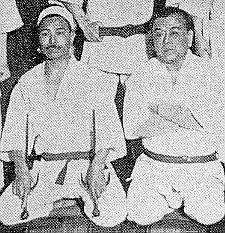
Shinken Taira (L) and Master Moden
Yabiku.
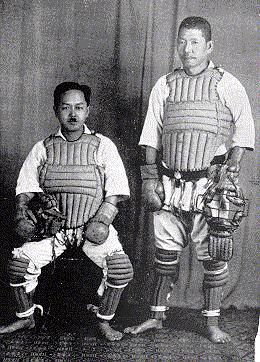
Master Mabuni (seated) experimenting with
protective equipment for combat
Over the next few years, master Mabuni dedicated himself to the further development and promotion of SHITO RYU karatedo in the Osaka area. He was faced with an extremely difficult task due to the unwillingness of the population to accept him or this strange looking system of self defence, resembling an ancient 'Okinawan-Fist Dance'. In order to bring Shito Ryu to the general public's attention, master Mabuni would perform many demonstrations where he would break bricks and boards to show the power of karate. Continually trying to gain acceptance of his art, master Kenwa Mabuni would give free instruction at various police stations across western Japan.
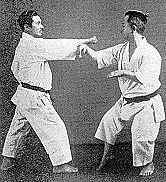
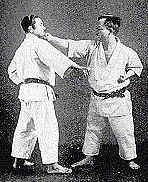
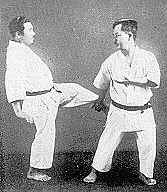
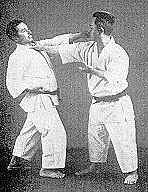
Eventually his enormous efforts began to finally pay-off with the establishment of the DAI NIHON KARATEDO KAI, in 1931. This original group later was the forerunner of the present World Shito-Kai Karatedo Federation. Shito Ryu Karatedo became more accepted after this time, and master Mabuni began to teach many students at his home and at many Universities that were forming clubs. Among his many students included were his two sons, Kenei Mabuni and Kenzo Mabuni, Chojiro Tani (founder of Tani-ha SHUKOKAI), Ryusho Sakagami, Yoshiaki Tsujikawa, Ken Sakio, Jun-ichi Inoue, Manzo Iwata, Toshiyuki Imanishi, Kazuo Kokuba, Tokio Hisatomi and Ryusei Tomoyori.
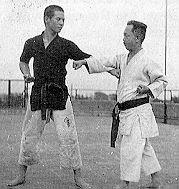
Manzo Iwata (L), Master Mabuni (R).
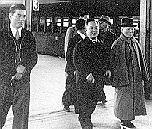
Ken Sakio ( L), Master Mabuni
(C),
Master Funakoshi (R).
During the Pacific War, many promising young karateka from the four major styles lost their lives, including from the Shito Ryu group. Master Mabuni barely survived the post-war turmoil, contending with great poverty but, he persevered and continued to devote himself unselfishly to the further development of Shito Ryu Karatedo. After the war, many of the previously established Shito Ryu Karate clubs in the universities and colleges began to re-open. By this time, the future of Shito Ryu Karatedo was assured by many of his surviving students the majority of which could be found on the East coast of Japan in the Kanto district.
Master Kenwa Mabuni died on May 23, 1952.
During November 1960, due to the colossal efforts of Master Manzo Iwata (1924-1993) an eastern Headquarters was finally established while, similtaneously, the western Headquarters was being re-established by Master Kenwa Mabuni's first born son, Master Kenei Mabuni (1918- ).The Chairmanship of the Eastern and Western Headquarters was assumed by Master Iwata and Master Kenei Mabuni respectively.
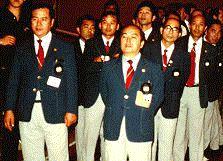
FirstRow (L-R) Master Manzo Iwata, Master Kenei
Mabuni.
SecondRow (L-R) Master Mikami, Master Kinjo.
Over the years, both Headquarters conducted separate special events, seminars and tournaments until the First All-Japan Shitoryu Karatedo Championships was held in April, 1964.
The establishment of the sports governing body for Karatedo in Japan, the Japan Karatedo Federation (J.K.F.), formerly known as the Federation of All-Japan Karatedo Organizations (F.A.J.K.O.) was created in October of the same year.
In February 1973, the Eastern and Western dual Headquarters of the Dai Nihon Karatedo Kai merged to become the JAPAN KARATEDO SHITOKAI.
![]()
With the culmination of various Shito-kai groups around the globe, including Cuba, Russia, Mexico, Asia, the Pan-American countries, South America, North America and Canada, the establishment of the WORLD SHITORYU KARATEDO FEDERATION was finally realized at the congress meeting in Osaka in March, 1993. The official, 1st. SHITORYU KARATEDO WORLD CHAMPIONSHIPS was held in the TOKYO BUDOKAN following the Osaka Congress.
The following is a literal translation of a quotation from Grand Master Kenwa Mabuni pertaining to 'dedicated training':
" FORGET MUNDANE THINGS WHEN STRIVING FOR THE MARTIAL ISLE... PADDLING IS JOY! "
References/Bibliography
Mabuni Kenwa/Nakasone Genwa Yoju-sha. Karate-do Nyumon. (Reprinted Edition) Feb. 28, 1996.
Mabuni Kenei/Nakahashi Hidetoshi.Karate-do Shito-ryu. Paris, France: SEDIREP, 1989.
Mabuni Kenei/Nakahashi Hidetoshi.Karate-do Traditionnel Shito-ryu. Paris, France:
SEDIREP, 1995.
Mabuni Kenei/Kassis Con. Shito-ryu Karate-do: Victoria, Australia. Dominie Press, 1997.
Nakaya Takao. Karate-do History and Philosophy. Carrollton, Texas: J.S.S. Publishing Co., 1986.
Corcoran John/Farkis Emil, Martial Arts-Traditions, History, People. New York: Gallery Books, An Imprint of W.H. Smith Publishers, Inc., 1983.
Mc Carthy Patrick. Classical Kata of Okinawan Karate. Burbank, California: Ohara Publications, Inc., 1987.
Mc Carthy Patrick. The Bible of Karate Bubushi. Tokyo, Japan: Charles E. Tuttle Co. Inc., 1995.
Bishop Mark. Okinawan Karate, Teachers, Styles and Secret Techniques. London, Great Britain: A & C Black (Publishers) Ltd., 1989.
O'Neill Terry. Fighting Arts International. Merseyside, England.
Sells John. Shito-ryu Karate, Okinawa's Not-so Hidden Secret: Karate Magazine Article.
Wong Curtis F. Kick Illustrated-The Magazine for Today's Total Martial Artist: CFW. Publications, 1982.
DeMarco Michael A. Journal of Asian Martial Arts. Erie, Pennsylvania: Via Media Publishing Co., 1994.
W.S.K.F.-World Shito-ryu Karate-do Federation Inaugural Magazine/Programme Issue: Tokyo, Japan. 1993.
Moledzki Sam. Personal Data & Photograph Archives: Toronto, Canada.